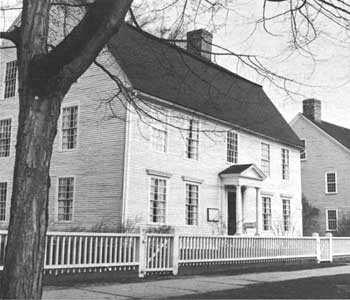





Survey of
Historic Sites and Buildings
 |
WEBB HOUSE Connecticut |
|
| ||
Ownership and Administration (1961). The Connecticut Society of the Colonial Dames of America (Headquarters of the Society).
Significance. In the spring of 1781, when the weight of active campaigning had shifted to Virginia and the Carolinas, Washington's army lay inactive in and around West Point. It was obvious that a combined offensive must be undertaken by the allies if the American cause were not to languish. War weariness had settled on the land, and much of the Continental Army was scattered along the frontier and in the South. The Webb House, in Wethersfield, Conn., was destined to be the scene of a conference that started the Americans and their French allies on the road to victory.
Washington learned in the middle of May that Count de Rochambeau, the French commander in America, desired a meeting to discuss the plan of campaign. Washington immediately accepted this opportunity to break the stalemate. The old Connecticut town of Wethersfield, lying about halfway between Washington's Hudson River headquarters at New Windsor and Rochambeau's headquarters at Newport, was selected as the place of meeting. On May 19 Washington arrived at Wethersfield and, in his own words, "lodged * * * at the house of Joseph Webb, Esq." On May 21 Washington rode to Hartford to meet Rochambeau, and the party returned to Wethersfield. The next day the French general confirmed that a French Fleet was en route to the West Indies and would be off the American coast by midsummer. Here at last lay an opportunity for concerted action. Rochambeau, however, gave Admiral de Grasse, the French naval commander, the option of joining the allied forces against the British in New York or in Virginia.
 |
| At the Webb House in Wethersfield, Conn., in May 1781, Generals Washington and Rochambeau planned American-French operations against the British in the closing campaigns of the War for Independence. (National Park Service) |
As a result of the conference Rochambeau brought his forces, numbering nearly 5,000 men, to join Washington in New York. Part of the original plan of attack by the allies was aimed at the British forts on Manhattan Island, but after thorough reconnaissance of the British fortified lines the effort was wisely abandoned, and Washington turned his attention to the developing situation in the south. On August 14 Rochambeau heard from Admiral De Grasse that the fleet, with a strong land force aboard, would sail from the West Indies for Chesapeake Bay, where it would be available only until October. Washington acted quickly to take advantage of this substantial reinforcement. He notified De Grasse that the Franco-American Army would march south to cooperate with the fleet in cornering Cornwallis in Virginia. If the trap failed, an attack on Charleston could be undertaken. This decision bore fruit in the entrapment and surrender of Cornwallis at Yorktown.
Although it is too much to say that the conference in the Webb House laid the specific plans for the victorious Yorktown campaign, it nevertheless marked the implementation of the Franco-American alliance in terms of actual field operations. The American and French Armies were united in time for them to move south and operate in conjunction with the French Fleet from the West Indies.
Present Appearance (1961). The Webb House was built in 1752 by Joseph Webb, who occupied it for 9 years before his death. With its well-proportioned exterior design and steep gambrel roof, the two-story house has considerable architectural interest. The south parlor, traditionally identified as the conference room, has been repaneled, and the house is excellently furnished, mostly by gifts from members of the Society of Colonial Dames. Several items of furniture, silver, and china belonged to the Webb family. The setting, suggestive of the 18th century, is enhanced by the broad, tree-lined street that passes in front, and by a number of old homes adjacent to it. [7]
 |
 |
http://www.cr.nps.gov/history/online_books/colonials-patriots/sitec1.htm
Last Updated: 09-Jan-2005